It is impossible to ignore the number of people affected by spinal cord and brain injuries and the need for new rehabilitation solutions. Each year more than seventeen thousand people in America are affected by spinal cord injuries, and about 1.5 million are affected by brain injuries. [1] As a result, 1 in 50 people in America, or nearly 5.4 million individuals, live with paralysis. [2]
Medical exoskeletons have been making waves in the healthcare industry, offering new hope for individuals with spinal cord and brain injuries. This industry has grown significantly in recent years, reaching a size of approximately $480 million in 2019, and is projected to reach $11.4 billion by 2027. [3] These wearable devices provide support to the body and can help patients regain mobility and independence. In this article, we delve into the impact of medical exoskeletons on both patients and physical therapists, exploring the ways in which these devices are revolutionizing rehabilitation and changing the lives of those affected by debilitating injuries.
What are Exoskeletons?
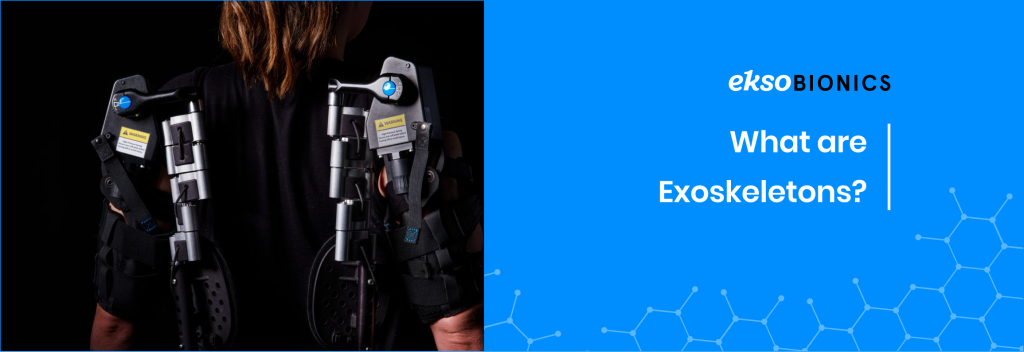
An exoskeleton is a wearable device that is designed to augment the strength and mobility of the human body. It is typically worn on the outside of the body and consists of a series of rigid frames or shells that are attached to the body using straps or other types of support. Some exoskeletons are powered by motors or hydraulics, while others rely on the user’s muscles to move.
Exoskeletons can be classified into two main categories: passive and active. Passive exoskeletons do not have any power source of their own and rely on the user’s muscle power to move. Active exoskeletons, on the other hand, have a power source and can assist or augment the user’s movements.
Exoskeletons are used in a variety of applications, including medical rehabilitation. Medical exoskeletons are designed to assist individuals with mobility impairments, such as spinal cord injuries or other brain injuries, to walk again. There are several different types of medical exoskeletons available, each of which works in a slightly different way. Some common features of medical exoskeletons include:
- Sensors: Many medical exoskeletons have sensors that detect the user’s movements and adjust the device accordingly. For example, sensors may be used to detect when the user is attempting to take a step and provide additional support and power to the leg muscles.
- Motors or hydraulics: Some medical exoskeletons have motors or hydraulics that provide additional power and support to the user’s muscles.
- Control systems: Most medical exoskeletons have a control system that allows the user to operate the device. This may be a handheld controller or a computer interface that the user can use to adjust the device’s settings and control its movements.
- Support structures: Medical exoskeletons often have support structures, such as frames or shells, that are attached to the body using straps or other types of support. These structures help to distribute the weight of the device and provide additional support to the user.
Overall, medical exoskeletons work by detecting the user’s movements and providing additional support and power to the muscles as needed. This can help individuals with mobility impairments walk again or perform tasks that may otherwise be difficult or impossible.
Types of Medical Exoskeletons
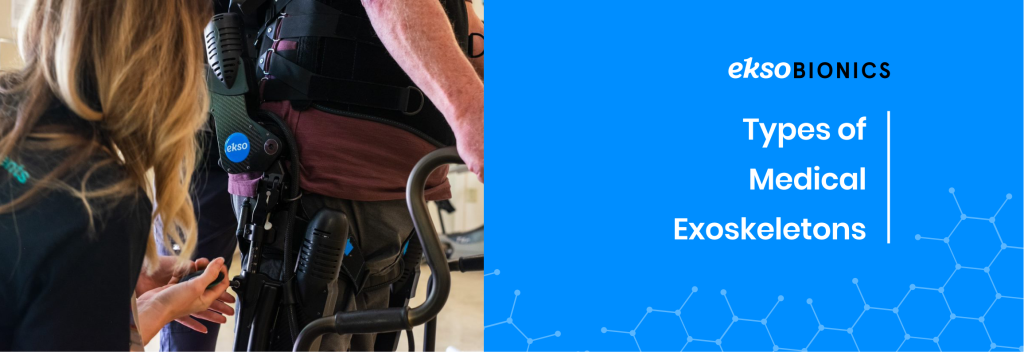
There are several different types of medical exoskeletons available, each of which is designed for a specific type of injury or application. [4] Some common types of medical exoskeletons include:
- Lower limb exoskeletons: These devices are designed to assist with walking and are typically worn on the legs and feet. They may have sensors that detect the user’s movements and provide additional power and support to the leg muscles as needed.
- Upper limb exoskeletons: These devices are designed to assist with upper body movements and are typically worn on the arms and shoulders. They may have sensors that detect the user’s movements and provide additional power and support to the arm muscles to help the user lift or carry objects.
- Hybrid exoskeletons: These devices combine features of both lower limb and upper limb exoskeletons, providing support for both the legs and arms. They may be used to assist with walking and upper body movements.
Medical exoskeletons are typically used in rehabilitation settings, such as hospitals or physical therapy clinics. Physical therapists may work with patients to adjust the settings on the exoskeleton and guide patients through exercises and activities to help them regain strength and mobility.
In addition to assisting with mobility, medical exoskeletons may also have other benefits for patients. For example, they may help to improve muscle strength, reduce spasticity, and prevent pressure sores. They may also have psychological benefits, such as increasing the patient’s confidence and independence.
Impact of Exoskeletons on Patients
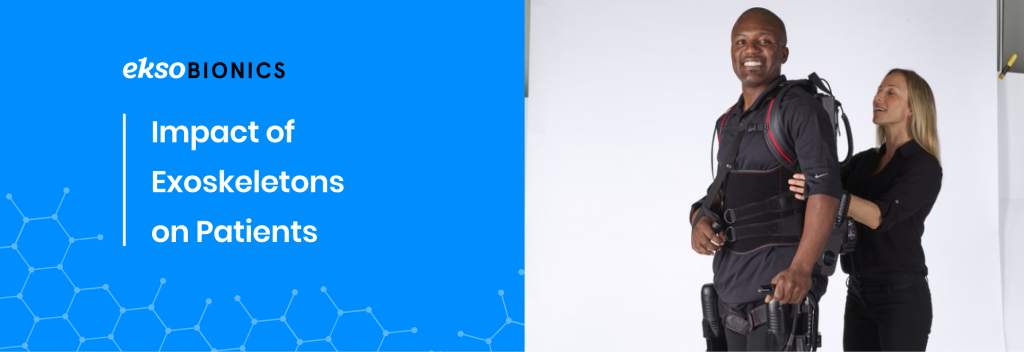
- Improves Muscle Strength and Spasticity:
Patients who are recovering from brain injuries including strokes usually tend to have reduced muscle strength in their legs. They are also likely to experience muscle stiffness and pain as a result of damage to specific areas of the brain. This is a common occurrence because leg muscles atrophy as a result of lack of use.
Physical therapy can help in this case, and in a 2021 study, research showed that exoskeletons could improve grip strength, quadriceps strength, and lower limb motor function. [5] Another 2019 study showed that exoskeletons significantly improved muscle strength and reduced spasticity. [6] In a 2020 study investigating the impact of a lower limb exoskeleton robot on the muscle strength of tibialis anterior muscle in stroke patients, researchers concluded that exoskeletons have the potential to improve muscle strength and lower limb motor function. [7]
- Improves Gait:
Gait training is a physical therapy technique that involves practicing walking patterns with the aim of improving mobility. It is often used to help people who have difficulty walking due to neurological conditions, such as stroke or cerebral palsy, or due to injuries or surgeries that have affected their ability to walk.
According to research, exoskeletons are effective in gait training as they are calibrated to help the wearer achieve natural gait. They also offer more gait repetitions compared to traditional rehabilitation methods. According to one study, “By the end of the training, the gait pattern of the patients improved and came closer to a healthy subject’s gait pattern.” [8]
Exoskeletons like EksoNR have built-in features that help regulate and observe leg movement to promote gait development and help patients balance, squat, weight shift, and even step in place before walking.
- Improves Quality of Life:
Beyond the physical benefits of exoskeletons, they also have the ability to enhance the patient’s life. It helps them to do things that they were not able to do before. For instance, it helps patients (even those with severe injuries) to exercise in an upright position. [5]
In some cases, it also gives patients the ability to walk. Physical therapist Kyle McIntosh says, “The exoskeleton lets patients take actual steps, which is not only more realistic but much less cumbersome,” McIntosh also says, “Every step is different with this device, so patients learn from their mistakes in real time. Patients really like to use the device; it gives them hope.” [9]
- Helps with Bladder and Bowel Function:
Exoskeletons come with other associated benefits, like improved bowel function. Researchers propose that the upright postures and physical activities that patients engage in while in exoskeletons play an important role in bowel motility. [10] In a 2019 study, researchers concluded that “patients who gained the ability to stand and walk with an exoskeleton often developed better endurance, improved their bowel and bladder control, and were less likely to develop urinary tract infections.” [11]
- Boosts Patient Moods:
According to patient feedback, exoskeletons offer hope and motivate patients to participate in their recovery journey. According to a 2021 study, patients’ moods were reported to have improved during the rehabilitation phase. There was also a decrease in fatigue and an improved quality of life. [5]
Other patients also cherish the ability to have eye-to-eye conversations with other people while wearing the exoskeletons. Additionally, since exoskeletons are a “new” invention, more patients are excited to try them out, which increases engagement levels. [11]
Patient Success Stories as a Result of Exoskeleton Rehabilitation
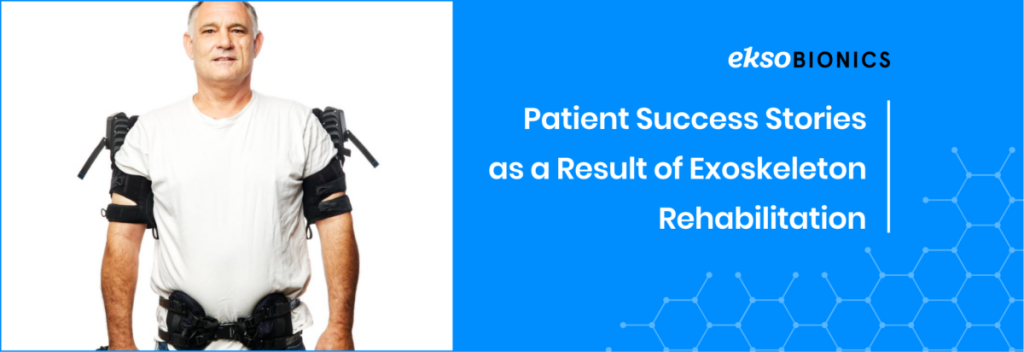
- Megan’s Story
Megan’s life took a turn in December 2015 when she had a stroke in her spinal cord. In 2016, she underwent a resectioning procedure, after which she was diagnosed with a T-12- incomplete spinal cord injury (iSCI). After her injury, Megan relied on a wheelchair to move around, but with hard work and physical therapy, she moved from a wheelchair to a wheeled walker to a cane and ankle foot orthoses (AFO). This was a huge win because her doctors had told her she would always depend on a wheelchair for movement.
Megan was still unsatisfied with her progress; in 2017, she learned about Ekso Bionics. While looking for rehabilitation help, she came across a study that wanted to compare Ekso rehab with traditional rehab for patients with incomplete spinal cord injuries. Megan signed up for the study and started participating in the trial in 2018. She was using Ekso for three days per week for 12 weeks, and by the twentieth session, Megan was walking without any assistance. And by the thirty-six session, she had achieved her recovery goal: golfing.
Interestingly, Megan still can’t feel her legs from the waist down, but from the Ekso training sessions, she has built up her leg muscles that keep her walking unassisted. Read Megan’s detailed exoskeleton rehabilitation recovery story.
- Kylie’s Story
In 2019, Kylie was in a coma. She had suffered an acquired brain injury plus multiple internal injuries. Once she regained consciousness, she began physical therapy, where she was able to attain incredible levels of self-initiated movement while using the EksoNR.
Her physical therapist, Erin, shared, “In the first session, we took maybe ten steps. And now she’s walking over 1,200 steps.” This recovery journey is considered massive for patients who are recovering from ABI. Read Kylie’s full recovery story.
- Kathy’s Story
Kathy was diagnosed with Multiple Sclerosis more than 20 years ago, and her symptoms have worsened over time. She got a chance to participate in a research study assessing the effectiveness of the EksoGT exoskeleton in MS rehabilitation, and when interviewed, she said, “My walking speed has increased, my endurance has improved, my gait is more normal and I get intermittent periods of my leg getting signals from my brain.” Read more about Kathy’s exoskeleton rehabilitation story and the research study.
Impact of Exoskeletons on Physical Therapists
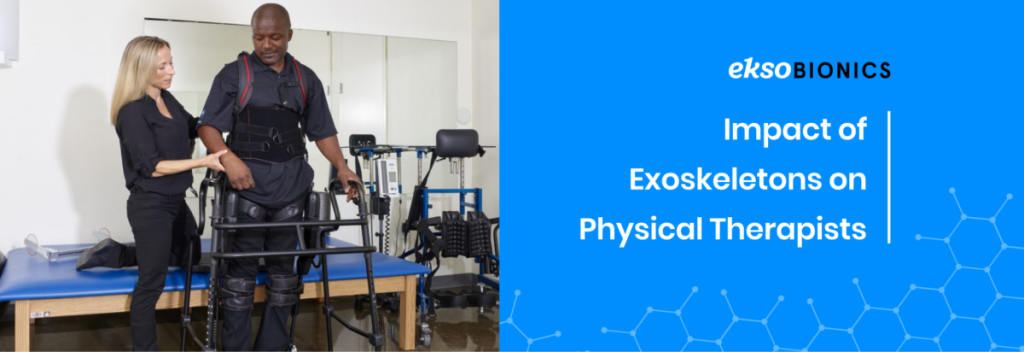
- Reduces Physical Burden on Physical Therapists
Traditional physical rehabilitation methods are labor-intensive and require a hands-on approach from therapists. This exposes them to work injuries and exhaustion. In a traditional setting, a patient may require two or three physical therapists to manually guide their limbs which can be unsafe. [12] Exoskeletons reduce the number of therapists needed to attend to a patient and minimizes exposure to injuries. This can help physical therapists offer better care to patients without being limited by fatigue.
- Reduces Hospital Costs
Exoskeletons can help physical therapists reduce clinical costs. According to a 2020 budget impact analysis of exoskeletons, exoskeletons reduced locomotor training costs by between $1,114 and $4,784 per year when used in 10% of annual locomotor training sessions. [13] This is a considerable amount of money when you consider the long-term implications.
What Other Physical Therapists Think About Exoskeleton Use

- “We’re finding that patients are progressing far beyond what we’ve ever been able to get them to because we have this means to get people up earlier.” – Dr. Christina Kwasnica, MD, Medical Director, Barrow Neurological Institute.

- “From my own experience, either therapists are physically carrying these patients across the gym at great expense to their own bodies, or they’re just not able to mobilize these patients; so many of our patients are very weak, and therapists absorb much because of the burden. The therapists I work with are now able to do so much more using Ekso.” – Dr. Craig DiTommaso, MD, FAAPMR Medical Director, Kindred Rehabilitation Hospital Northeast Houston.

- “Ekso, if qualified, is a more efficient intervention than the body-weight supported treadmill that we do for ABI patients. In terms of logistical manpower, the control of the quality of the gait pattern and repetition for motor learning. I do think that Ekso is a good intervention for early mobilization, tapping into neuroplasticity expediently and more successfully. – Edward Cruz, PT, DPT, Physical Therapist, University of Texas Southwestern Medical Center.

- “We went from taking 20 steps with three physical therapists to taking hundreds of steps in a session with one.” – Diane Patzer, DPT Physical Therapist, Rehabilitation Institute Of Michigan.

- “We were able to see immediate impact on the patient’s ability to perform bed mobility, transfers, and independence with all functional activities after one session with the device. This device has greatly improved our patient’s outcomes while decreasing physical assistance required by staff members.”- Duncan Monger. PT, DPT, CBIS, Regional One Health Inpatient Rehabilitation Hospital

Conclusion
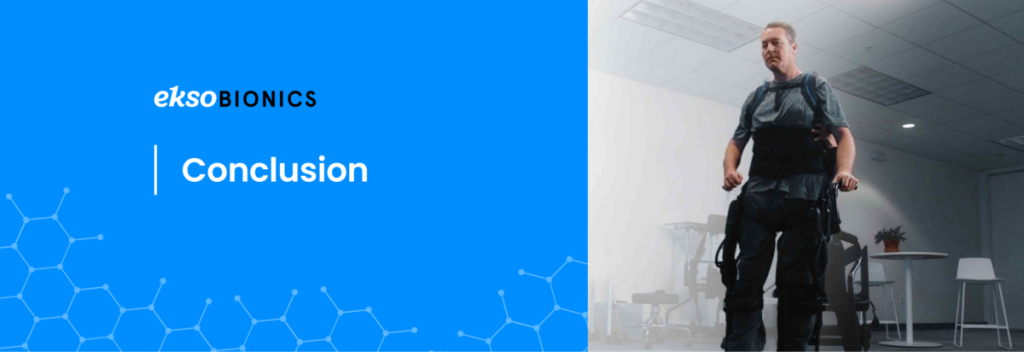
In conclusion, medical exoskeletons have a positive impact on both patients and physical therapists. For patients, these devices provide support and assistance with mobility, allowing them to perform daily activities with greater ease and independence. For physical therapists, exoskeletons serve as useful tools for rehabilitation and training while lowering costs. More research is needed to fully understand the long-term effects of using medical exoskeletons. However, the bottom line remains that exoskeletons will continue improving and becoming a bigger and bigger part of physical therapy.
For the last 10+ years, we have been developing technology that helps patients walk again. Our efforts have yielded great results with happy physical therapists and satisfied patients. Our FDA-approved exoskeletons are used in over 400 centers worldwide to help patients who are recovering from stroke, brain injury, spinal cord injury, or Multiple Sclerosis. Contact us today to make an inquiry or learn more about our products.
References:
- Report to Congress: Traumatic Brain Injury in the United States | Concussion. https://www.cdc.gov/traumaticbraininjury/pubs/tbi_report_to_congress.html#:~:text=Traumatic%20brain%20injury%20(TBI)%20is,people%20are%20hospitalized%20and%20survive
- Paralysis statistics – Reeve Foundation https://www.christopherreeve.org/living-with-paralysis/stats-about-paralysis
- Worldwide market for exoskeletons 2027 | Statista https://www.statista.com/statistics/888936/global-exoskeleton-market/
- Exoskeletons for Personal Use After Spinal Cord Injury. https://pubmed.ncbi.nlm.nih.gov/31228407/#:~:text=Robotic%20exoskeletons%20can%20allow%20individuals,for%20personal%20mobility%20or%20exercise
- Physiotherapy using a free-standing robotic exoskeleton for patients with spinal cord injury: a feasibility study | Journal of NeuroEngineering and Rehabilitation https://jneuroengrehab.biomedcentral.com/articles/10.1186/s12984-021-00967-4
- Retraining walking over ground in a powered exoskeleton after spinal cord injury: a prospective cohort study to examine functional gains and neuroplasticity – PMC https://www.ncbi.nlm.nih.gov/pmc/articles/PMC6868817/
- Impacts of a lower limb exoskeleton robot on the muscle strength of tibialis anterior muscle in stroke patients https://www.researchgate.net/publication/344023059_Impacts_of_a_lower_limb_exoskeleton_robot_on_the_muscle_strength_of_tibialis_anterior_muscle_in_stroke_patients/fulltext/5f519787a6fdcc9879c9cc2f/Impacts-of-a-lower-limb-exoskeleton-robot-on-the-muscle-strength-of-tibialis-anterior-muscle-in-stroke-patients.pdf
- Robot Assisted Gait Training With Active Leg Exoskeleton (ALEX) | IEEE Journals & Magazine https://ieeexplore.ieee.org/document/4663875
- Spinal cord injury patients may benefit from using exoskeleton earlier in treatment | News | University of Calgary https://ucalgary.ca/news/spinal-cord-injury-patients-may-benefit-using-exoskeleton-earlier-treatment
- Changes in Bowel Function Following Exoskeletal-Assisted Walking in Persons with Spinal Cord Injury: An Observational Pilot Study – PMC https://www.ncbi.nlm.nih.gov/pmc/articles/PMC7145720/
- Robotic Exoskeletons May Provide Health Benefits for People with Spinal Cord Injuries | National Rehabilitation Information Center https://naric.com/?q=en/content/robotic-exoskeletons-may-provide-health-benefits-people-spinal-cord-injuries
- How can powered exoskeletons restore walking ability after stroke? – Physics World https://physicsworld.com/a/how-can-powered-exoskeletons-restore-walking-ability-after-stroke/
- Budget impact analysis of robotic exoskeleton use for locomotor training following spinal cord injury in four SCI Model Systems | Journal of NeuroEngineering and Rehabilitation https://jneuroengrehab.biomedcentral.com/articles/10.1186/s12984-019-0639-0